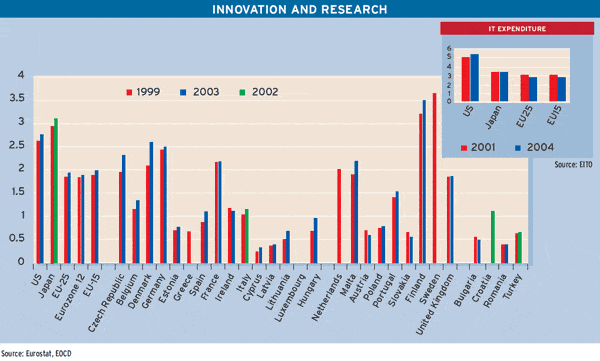The European Union wants to create a region-wide knowledge-based economy. Realizing that vision is proving to be a major headache.
 |
|
|
Behind the economic travails of individual EU countries, a much bigger issue is at stake, which has far-reaching implications for the EU as a whole. In 2000 in Lisbon, Portugal, the European Council announced its Lisbon Strategy, which declared the EU would become the worlds most dynamic and competitive economy by 2010. At the heart of the Lisbon Strategy is the concept of transforming Europe into a knowledge-based economy, with sectors such as high-tech, services, software, telecommunications and research centers becoming key drivers for economic growth and productivity.
Alain Quvreux, head of the Europe department at Paris-based ANRT (Association Nationale de la Recherch Technique), which conducts research on behalf of the European Commissions Enterprise Directorate-General, defines a knowledge economy as one based on validating and creating value from knowledge, which he says is a sea change from traditional industry thinking. It [a knowledge economy] is not about starting from what you have achieved before, but instead looking at new capacities to innovate, he explains.
In some parts of Europethe United Kingdom, France, Germany, Spain, Ireland and the Nordic countriesthe move toward becoming knowledge based is progressing apace, evidenced by those countries sustainable investment in R&D; and flourishing high-tech industry sectors. Increasingly, though, academics, researchers and policy makers are concerned that the transformation will remain patchy. With the recent EU enlargement, this concern has become even more pressing. As more countries join, there are fears that they wont be able to compete on an equal footing.
A Fork in the Road
With few of its targets met and unemployment in its largest economies remaining stubbornly high, the EU is finding its Lisbon Strategy dubbed an embarrassing debacle by some critics. They have a point: The EU is anything but a harmonious whole. The single currency hasnt prompted economic convergence; in fact, EU ministers have expressed alarm at the divergent economic growth rates across the eurozone, which was highlighted in the first half of 2005 when the German economy reported growth of 1% while the Italian economy plunged into technical recession with first-quarter 2005 growth of -0.5%.

Evidence continues to mount, though, that regions within the EU may be on a different trajectory when it comes to their ability to meet the objectives of the Lisbon Strategy. R&D; expenditure, one of the cornerstones of a knowledge-based economy, is wildly divergent across the EU. Figures published by Eurostat, the EC statistical agency, highlight regional disparities in R&D; expenditure with areas such as Braunschweig in Germany (7.15% of GDP on R&D;), northern Finland (4.2%) and eastern England (3.9%) spending more than other parts of the country. Those regions with the highest levels (above 2.9%) of R&D; expenditure were concentrated mainly in Germany (11 regions), Finland (3), France, Austria and the UK (2 regions each), and the Netherlands, Sweden and the Czech Republic (1 region each), with lower expenditure in the southern and eastern parts of Europe.
Historically, R&D; expenditure has been used as an indicator for measuring innovation performance within the EU; however, Quvreux says the focus is now shifting from input indicators (assets) to output indicators. It is not about giving public money to support innovation but what happens after the supportin other words, do companies become more competitive at a global level? he explains. Research conducted by Quvreux on behalf of the EC Enterprise and Industry Directorate-General highlighted regional disparities, with northern parts of Europe (Finland, Sweden, Scotland) focusing more on output indicators for innovation than regions in southern Europe.
Mapping Europe
ESPON has created a map based on a selection of the 14 Lisbon indicatorsincluding GDP/capita, employment rate, employment of older workers, gross domestic expenditure on R&D;, dispersion of regional unemployment and long-term unemploymentto try to track various countries progress. Mehlbye says the map clearly shows that northern and central Europe are better off than the south and the east in terms of their ability to meet the Lisbon economic criteria. ESPONs findings highlight a zone of high performance that runs from Stockholm via Norway and Denmark (plus one region in eastern Scotland), through the south-east of England, on through spots in the Benelux countries and Germany, to Switzerland and some regions in Austria. It also found strong regional concentration within urban areas such as Budapest and Madrid, which performed more strongly when benchmarked against the Lisbon economic indicators than peripheral or outlying regions. What weve found is that there is diversity in the potential of different areas, cities and larger territories of Europe to contribute to the fulfillment of the Lisbon strategy, says Mehlbye.
ESPONs findings are also reflected in the EU Innovation Scoreboard (EIS), which measures innovation performance across Europe based on a revised list of 26 indicators designed to provide European regions with a broader picture of how they are really performing. The 2005 scoreboard shows that northern Europe (Finland and Switzerland followed by Germany and Denmark) are the innovation leaders, while newer EU member countries (Latvia, Lithuania, Czech Republic, Portugal, Hungary, Slovenia, Greece) are catching up, but at a slower pace that is unlikely to result in EU convergence any time soon. The EIS also concluded that the innovation and competitiveness gap between the EU and the US would not close within the next 50 years.
What Next?
So what are the implications for the Lisbon Strategy? Mehlbye does not want to poke holes in the Lisbon Strategy, but he says that its implementation needs to be approached in an intelligent way. Taking the new European information on regional diversity into account should result in more clever, targeted policies in the future for enhancing regional strategies, he says, adding that regions need to assess whether they should have a high or low ambition toward becoming a knowledge-based economy. There may be other strong points and comparative advantages for a region that would make more sense to go for, he says.
Quvreux asserts that diversity is a fact of life within the EU and that there is no standard recipe for success that all EU member states can follow in their efforts to meet the objectives of the Lisbon Strategy. Each region or metropolitan area has to find their own way and evaluate and understand what level of innovation they can achieve, he says. He cites the example of successful regions within Europe such as Wageningen, a small city in the Netherlands, which Quvreux says successfully combined local competencies as well as cooperation with Danish and French research institutes to increase Europes success in the food industry. Commenting on its success, Quvreux says, There needs to be a clear regional strategy to develop the capacity to innovate and some models to monitor thatwhat he describes as a regional business plan.
The EUs Sixth Framework Programme (2002-2006) for Research and Technological Development fulfills that need, to an extent. It is based on the proposition that innovation strategies should be formulated at the regional level by establishing collaborative networks between various stakeholders to identify innovation opportunities. But Quvreux insists that policy makers should adopt a different approach: Many policy makers had in mind that by adding innovation support to existing policies they would achieve a better performance, but that is not the way it works. Quvreux says that, as major providers of financing, banks also need to adapt to the requirements of an innovative knowledge-based economy. Whether or not these innovative projects will succeed is questionable. This can be risky for the banks, he explains. Financial service providers need to transform the uncertainty of this new mix into more of a risk appraisal situation.
In an effort to counter some of the criticisms leveled at the Lisbon Strategy, the EC notes in its 2006 progress report on jobs and growth that the strategy has entered a new phase focused on delivering resultshence the emphasis on tools for monitoring and evaluating innovation projects in each region. By submitting national reform programs, the EC says EU member states have accepted a new responsibility, setting out detailed commitments for action. What is needed now, it adds, is the political will to translate these commitments into action in the form of economic growth and employment.
It also called for higher levels of public spending on research, innovation and education. But is that enough, and will every region within Europe equally benefit from such measures? Given Europes diversity, Quvreux says there will always be some regions that lag behind when it comes to the development of a knowledge economy. But he says Europe in that sense is no different from China or the US. North Dakota is different from California, for example, in terms of regional development opportunities, he says.
Gordon Platt



